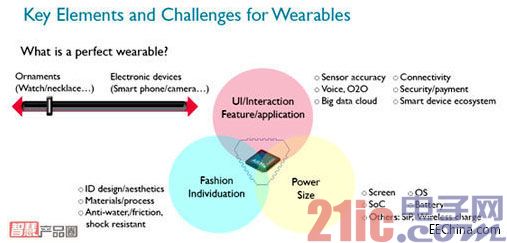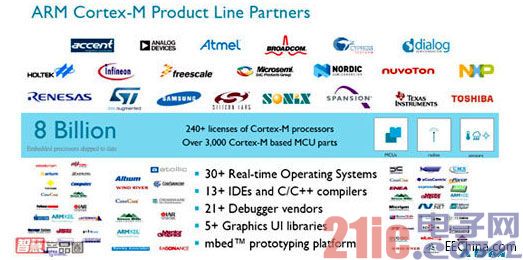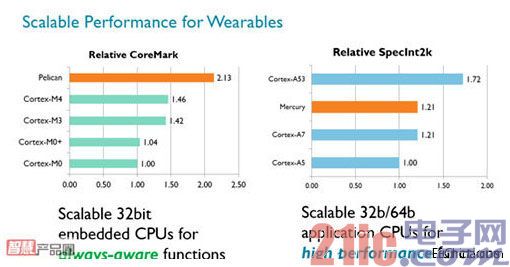Since last year, the wearable industry has begun to flourish, and a variety of innovative wearable devices are constantly being introduced to the market. At present, more than 90% (300-500) of wearable devices on the market are designed based on ARMIP technology, including smart bracelets/wristbands such as GearFit, Fitbit, Misfit, Samsung, Sony, Pebble, Adidas, Turman and other smart phones. Watches, as well as the current mainstream AndroidWear smart watches on the market include Moto360, as well as GoPro portable cameras, OakleyAirwave mirrors, Kopin's wearable computers Golden-i and so on.
This article refers to the address: http://

Figure 1: AndroidWear smart watch based on ARMIP technology.
According to ARM, as of the end of 2013, the cumulative shipments of chips based on ARM technology exceeded 50 billion, of which the embedded field including industrial control contributed about 20%; the Internet of Things including wearable devices It is a diversified and diversified market application. In this market, ARM continues to create an open and win-win ecosystem operation model. Through a variety of IP options including processors and multimedia processors, chip manufacturers can The application for its own launches the right chip products, which in turn leads to the diversification of market products and allows more innovation to drive market development.
Hardware-based, eco-friendly and new business models
“Many people will ask if wearable products, especially watches and bracelets, are made more like consumer electronics such as mobile phones, cameras or more like accessories/accessories? Personally, the appropriate product form should have the characteristics of traditional jewelry. And with intelligent functions, it brings convenience and practical value to consumers.†Zou Cheng, senior market manager of ARM China, said on September 25th, “2014 China Smart Wear Industry Summit Forum†hosted by Siruida Media. Road. Taking smart watches as an example, the beautiful appearance of traditional watches and many intelligent functions (see information/time/calendar, listening to music, alarm clock function, intelligent connection with cloud control devices and micropayment functions, etc.) will create a Very good application.
Good-looking, easy-to-use, and worry-free are the key elements that wearable products are widely accepted by users, as shown in Figure 1. Requires a dazzling appearance, stylish personality, you need to use a small chip or display components and a perfect structural design; requires powerful functions, user experience, which requires power consumption problems, and low-power design and Design balance problem such as connectivity and interface display effect; requires peace of mind, can be used continuously for a long time, and is applicable to a variety of use scenarios, and it needs to include waterproof and anti-wear functions to meet the use in swimming, sports and other scenarios. On the basis of hardware devices, it is also necessary to create an ecological and new business model around hardware.

Figure 2: Three key elements of wearable devices / challenges.
"To be wearable (smart hardware), we must jump out of the thinking and operation mode of hardware items, consider the ecological and commercial value behind it, and fully exploit the value in the application level, network operation, social field and other aspects." Sincerely said. Take the GoPro camera for the extreme sports industry as an example. Its hardware design is not complicated. There is not much adjustment from HERO2 to HERO3 hardware, but it is highly concerned and sought after by the investment community, industry insiders and ordinary users. The reason is that there are very large new business models and imaginations on the hardware products that they envision. GoPro recently announced that it will create a media eco-social industry circle by producing video and production media. GoPro will transform from a camera manufacturer to a media company – a manufacturer and distribution channel for a specific brand of content. It can be seen that on the basis of the hardware, an ecological environment can be built around the hardware, so that the wearable product has more imagination in the future.
ARM's layout in the wearable market
Wearable is an application market with diversified products and diversified industrial chain components. "ARM's IP technology is known for its low power consumption. With the current Cortex-A and Cortex-M product lines, it can meet the diverse needs of the wearable market," ARM said. The ARM architecture is an open platform. In addition to Android on the operating system, it also works with Linux, Windows and many RTOS partners. The ARM Cortex-M series products are currently used by more than 90% of wearable device manufacturers on the market, with 8 billion chip shipments (including 8-bit MCUs). In addition, ARM recently released the Cortex-M7IP core.

Figure 3: At present, shipments based on ARMCortex-M series core chips reach 8 billion.
For different market applications in the wearable field, ARM has a variety of corresponding products. For basic bracelet products, mainly with the Cortex-M series of MCUs, the ARMCortex-M series can fully meet the low power and low cost requirements of these products. In addition, Cortex-M can be used with a variety of sensors. Integration helps meet the product's need for low power and high integration.
Mid-range wearable products such as smart watches, there are two main types of platforms, one is based on Cortex-M3/M4, and can run real-time operating system; the other is to support rich application operating system, can use Cortex-A5/ A7 is equipped with the platform of Mali-400.

Figure 4: The Cortex-A series offers greater processing power to meet the needs of mid- to high-end wearables.
For high-end eyewear products, the dual-core Cortex-A7 with the Mali-400 is similar in demand type to the low-end smartphone platform.

Figure 5: Choosing the most appropriate IP core based on product positioning and functionality.
“Because wearable products are diversified, participants are also diversified, including makers, smart hardware vendors, and Internet companies. Among them, makers and smart hardware manufacturers focus on the development of wearable terminal hardware devices, large Internet companies are more focused on the provision of platforms, and are more optimistic about the wearable solutions that cooperate with platform vendors, because they believe that the maturity of the wearable market is not based on simple independent hardware products, products that can be combined with applications and services to have better users. The use of stickiness.†ARM said in an interview with the “Smart Product Circle†in the “2014 China Smart Wear Industry Summit Forumâ€, “In the rapid realization of differentiated design, ARM and its more than 350 chip partners, more than 1,000 Home industry eco-partners provide support for related technologies on ARM-based platforms. On the one hand, they can provide multiple chip options for various applications, and on the other hand, they provide rich resources in software development."
In addition to the solutions currently offered by ARM in the wearable field, ARM has also been discussing with partners for low-power solutions including CPU, GPU, bus, physical IP, etc., and will even develop wearable devices in the future. Some proprietary IT technologies are used by chip companies to drive innovation and growth in this market.
to sum up
The wearable market is still in a state of preparation, and there is still a long way to go in terms of power consumption and hardware design, but there is no doubt that the wearable market has a lot of innovation and unlimited potential to predict it. It will change all aspects of human life.
NTC temperature surface mount sensors are non intrusive type sensors consisting of a probe section designed for mounting to flat or curved surfaces.
Cables can be supplied with insulation or jacket in PVC, Teflon or Silicon. Some cables are also available with a stainless steel over-braid or stainless steel armor for additional protection.
With the properties of easy installation, surface temperature measurement, surface mount type NTC Temperature Sensor has been used to power supply, radiator, electric motor and generator. Temperature range is from -30°C to 105°C.
Surface Mounting Sensor
Surface Mounting Sensor,Surface Mount Sensor,Sensor Radiator,Surface Mount Ntc Sensor
Feyvan Electronics Technology Co., Ltd. , http://www.fv-cable-assembly.com
